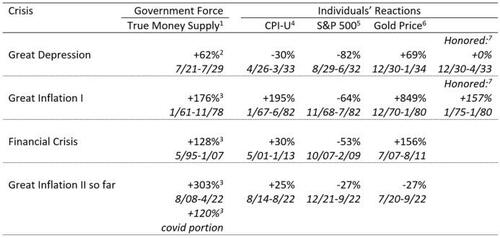Spooky Torts: The 2022 List Of Litigation Horrors
Here is my annual list of Halloween torts and crimes. Halloween of course remains a holiday seemingly designed for personal injury lawyers around the world and this year’s additions show why. Halloween has everything for a torts-filled holiday: battery, trespass, defamation, nuisance, product liability and more. Particularly with the recent tragedy in South Korea, our annual listing is not intended to belittle the serious losses that can occur on this and other holidays. However, my students and I often discuss the remarkably wide range of torts that comes with All Hallow’s Eve.
So, with no further ado, here is this year’s updated list of actual cases related to Halloween.
In October 2021, Danielle Thomas, former exotic dancer known as “Pole Assassin” (and the girlfriend of Texas special teams coach Jeff Banks), found herself embroiled in a Halloween tort after the monkey previously used in her act bit a wandering child at the house of horror she created for Halloween. Thomas considers the monkey Gia to be her “emotional support animal.”
Thomas goes all out for the holiday and converted her home into a house of horrors, including a maze. She said that the area with Gia was closed off and, as for petting, “no one is allowed to touch her!” She publicly insisted “No one was viciously attack this a lie, a whole lie! She was not apart of any haunted house, the kid did not have permission to be on the other side of my property!” She even posted a walk-through video of the scene to show the steps that a child would have to take to get to the monkey.
Don’t worry folks I got the #MonkeyGate video pic.twitter.com/TAy6leBqDS
— Christian Sykes (@ctsykes13) November 2, 2021
She insists in the video that she knows all of the governing legal rules and shows the path in detail. It is not helpful on the defense side: it is not a long path and easy to see how a child might get lost. She later deleted her account (likely after her attorney regained consciousness).
The case raises an array of torts including animal liability, licensee liability, negligence, and attractive nuisance claims.
In 2022, we often added conversion to the usual torts where multiple versions of the new giant skeleton were stolen, including one particularly ham-handed effort in Austin, Texas caught on video tape:
* * *
In Berea, Ohio, the promoters of the 7 Floors of Hell haunted house at the Cuyahoga County Fairgrounds appreciate realism but one employee took it a bit too far. An actor brandished this real bowie knife as a prop while pretending to stab an 11-year-old boy’s foot. He then stabbed him.
The accident occurred when the actor, 22, approached the boy and stabbed at the ground as a scare tactic. He got too close and accidentally cut through the child’s shoe, piercing a toe.
The injury was not serious since the boy was treated at the scene and continued through the haunted house.
The case raises an interesting question of “respondeat superior” for the negligent acts by employees in the course of employment. The question is what is in the scope of employment. The question is often whether an employee was on a “detour” or “frolic.” A detour can be outside of an employer’s policies or guidelines but will be the basis for liability as sufficiently related to the employment. A frolic is a more serious deviation where the employee is acting in his own capacity or for his own interests.
In this case, the actor was clearly within his scope of employment in trying to scare the visitors. However, he admitted that he bought the knife in his personal capacity and agreed it “was not a good idea” to use it at the haunted house, according to FOX 8. That still does not negate the negligence — both direct and vicarious liability. There was a failure to monitor employees and safeguard the scene. His negligence is also likely attributable to the employer. Finally, this would constitute battery as a reckless, though unintended, act.
* * *
In 2020, parents in Indiana were given a warning in a Facebook post that the Indiana State Police seized holiday edibles featuring packaging that resembles that of actual name brands — but with the word “medicated” printed on the wrapper along with cannabis symbols.
The packaging makes it easy for homeowners to confuse packages and give out drugged candy. Indeed, last year, two children were given THC-infused gummies while trick-or-treating, according to police in Waterford, Conn.. Such candies include the main active ingredient linked to the psychedelic effects of cannabis – the plant from which marijuana is derived.
Even an accidental distribution of such infused candies would constitute child endangerment and be subject to both negligence and strict liability actions in torts.
* * *
I previously have written how the fear of razor blades in apples appears an urban legend. Well, give it enough time and someone will prove you wrong. That is the allegation of Waterbury, Connecticut police who say that Jason A. Racz, 37, put razor blades in candy bags of at least two trick-or-treaters. Racz’ razor defense may not be particularly convincing to the average juror. According to police, “Racz explained that the razor blades were accidentally spilled or put into the candy bowl he used to hand out candy from.” However, police noted that he “provided no explanation as to how the razor blades were handed out to the children along with the candy.”
The charge was brought soon after Halloween in 2019. Racz is now charged with risk of injury to a minor, reckless endangerment and interfering with a police officer. He could also be charged with battery and intentional infliction of emotional distress, but it is not clear if any children were injured.
* * *
Steven Novak, an artist from Dallas, Texas, believes that Halloween should be a bit more than a traditional plastic pumpkin and a smiling ghost. Police were called to his home in Texas over a possible murder. They found a dummy impaled on a chainsaw with fake blood; another dummy hanging from his roof; a wheelbarrow full of fake dismembered body parts and other gory scenes. Neighbors called the display too traumatizing. Police responded by taking pictures for their families.
A tort action for intentional infliction of emotional distress is likely to fail. There must be not just outrageous conduct but conduct intended to cause severe emotional distress. Courts regularly exclude injuries associated with the exercise of free speech or artistic expression . . . even when accompanied by buckets of fake blood.
* * *
The Dorney Park and Wildwater Kingdom in Pennsylvania tells customers that, if they come to their Halloween Haunt, “Fear is waiting for you.” In 2019, a new case was filed by Shannon Sacco and her daughter over injuries sustained from “unreasonable scaring.” They are seeking $150,000.
The Allentown Morning Call reported that “M.S.” went with friends to the amusement park and was immediately approached by costumed characters. She said that she told them that she did not want to be scared and backed away. A little further on into the park however a costumed employee allegedly ran up behind her and shouted loudly. The startled girl fell forward and suffered what were serious but unspecified injuries. She alleges ongoing medical issues and inability to return to fully functioning activities. The lawsuit also alleges that the park failed to inform Sacco or her daughter that they could buy a glow-in-the-dark “No Boo” necklace to ward off costumed employees. The obvious issue beyond the alleged negligence of the Park is the plaintiffs’ own conduct. Pennsylvania is a comparative negligence state so contributory negligence by the plaintiffs would not be a bar to recovery. See Pennsylvania General Assembly Statute §7102. However, it is a modified comparative negligence state so they must show that they are 50 percent or less at fault. If they are found 51 percent at fault, they are barred entirely from recovery. Even if they can recover, their damages are reduced by the percentage of their own fault in going to a park during a Halloween-themed event.
* * *
In 2019, there is a rare public petition to shutdown a haunted house that has been declared to be a “torture chamber.” The move to “shut down McKamey Manor” that has been signed by thousands who believe Russ McKamey, the owner of McKamey Manor, has made his house so scary that it constitutes torture, including an allegation of waterboarding of visitors. The haunted house requires participants to get a doctor’s note and sign a 40-page waiver before they enter. People are seeking the closure of the houses located in Summertown, Tennessee and Huntsville, Alabama. McKamey insists that it is just a “crazy haunted house” and stops well short of the legal-definition of torture. The question is whether consent vitiates any extreme frights or contacts.
He is also clear in both the waiver and the website that the house is an “extreme haunted attraction” for legal adults who “must be in GREAT HEALTH to participate.” Not only do people enter with full knowledge but there is no charge. McKamey owns five dogs and only requires a bag of dog food for entry. Presumably the food is cursed.
* * *
An earlier case was recently made public from an accident on October 15, 2011 in San Diego. Scott Griffin and friends went to the Haunted Trail in San Diego. The ticket warns of “high-impact scares” along a mile path with actors brandishing weapons and scary items. Griffen, 44, and his friends went on the trail and were going out of what they thought was an exit. Suddenly an actor jumped out as part of what the attraction called “the Carrie effect” of a last minute scare. While Griffen said that he tried to back away, the actor followed him with a running chain saw. He fell backwards and injured his wrists.
The 2013 lawsuit against the Haunted Hotel, Inc., in the Superior Court of California, County of San Diego, alleged negligence and assault. However, Superior Court Judge Katherine Bacal granted a motion to dismiss based on assumption of the risk. She noted that Griffin “was still within the scare experience that he purchased.” After all, “Who would want to go to a haunted house that is not scary?”
Griffen then appealed and the attorney for the Haunted Hotel quoted Hunter S. Thompson: “Buy the ticket, take the ride.” Again, the court agreed. In upholding the lower court, Justice Gilbert Nares wrote, “Being chased within the physical confines of the Haunted Trail by a chain saw–carrying maniac is a fundamental part and inherent risk of this amusement. Griffin voluntarily paid money to experience it.”
* * *
In 2018, a case emerged in Madison, Tennessee from the Nashville Nightmare Haunted House. James “Jay” Yochim and three of his pals went to the attraction composed of four separate haunted houses, an escape room, carnival games and food vendors. In the attraction, people are chased by characters with chainsaws and other weapons. They were not surprised therefore when a man believed to be an employee in a Halloween costume handed Tawnya Greenfield a knife and told her to stab Yochim. She did and thought it was all pretend until blood started to pour from Yochim’s arm. The knife was real and the man was heard apologizing “I didn’t know my knife was that sharp.”
It is not clear how even stabbing with a dull knife would be considered safe.
The attraction issued a statement:
“As we have continued to review the information, we believe that an employee was involved in some way, and he has been placed on leave until we can determine his involvement. We are going over all of our safety protocols with all of our staff again, as the safety and security of all of our patrons is always our main concern. We have not been contacted by the police, but we will cooperate fully with any official investigation.”
The next scary moment is likely to be in the form of a torts complaint. Negligence against the company under respondeat superior is an obvious start. There is also a novel battery charge where he could claim that he was stabbed by trickery or deceit of a third person. There are also premises liability issues for invitees. As for Greenfield, she claims to have lacked consent due to a misrepresentation. She could be charged with negligence or a recklessness-based theory of battery, though that seems less likely. Finally, there is an interesting possible claim of negligent infliction of emotional distress in being tricked or misled into stabbing an individual.
* * *
Last year, a 21-year-old man surnamed Cheung was killed by a moving coffin in a haunted house in Hong Kong’s Ocean Park. The attraction is called “Buried Alive” and involves hopping into coffins for a downward slide into a dark and scary space. The ride promises to provide people with the “experience of being buried alive alone, before fighting their way out of their dark and eerie grave.” Cheung took a wrong turn and went backstage — only to be hit by one of the metal coffins. The hit in the head killed Cheung who was found later in the haunted house.
While there is no word of a tort lawsuit (and tort actions are rarer in Hong Kong), the case is typical of Halloween torts involving haunted houses. The decor often emphasizes spooky and dark environs which both encourage terror and torts among the participants. In this case, an obvious claim could be made that it is negligence to allow such easy access to the operational area of the coffin ride — particularly in a dark space. As a business invitee, Cheung would have a strong case in the United States.
* * *
A previous addition to the Spooky torts was the odd case of Assistant Prosecutor Chris White. White clearly does not like spiders, even fake ones. That much was clear given his response to finding fake spiders scattered around the West Virginia office for Halloween. White pulled a gun and threatened to shoot the fake spiders, explaining that he is “deathly afraid of spiders.” It appears that his arachnophobia (fear of spiders) was not matched by a hoplophobia (fear of firearms).
The other employees were reportedly shaken up and Logan County Prosecuting Attorney John Bennett later suspended White. Bennett said “He said they had spiders everyplace and he said he told them it wasn’t funny, and he couldn’t stand them, and he did indeed get a gun out. It had no clip in it, of course they wouldn’t know that, I wouldn’t either if I looked at it, to tell you the truth.” It is not clear how White thought threatening the decorative spiders would keep them at bay or whether he was trying to deter those who sought to deck out the office in a Halloween theme. He was not charged by his colleagues with a crime but was suspended for his conduct.
This is not our first interaction with White. He was the prosecutor in the controversial (and in my view groundless) prosecution of Jared Marcum, who was arrested after wearing a NRA tee shirt to school.
* * *
Another new case from the last year involves a murder. Donnie Cochenour Jr., 27, got a seasonal break (at least temporarily) on detecting his alleged murder of Rebecca J. Cade, 31. Cade’s body was left hanging on a fence and was mistaken by neighbors as a Halloween decoration. The “decoration” was found by a man walking his dog and reported by construction workers. A large rock was found with blood on it nearby. Donnie Cochenour Jr., 27, was later arrested and ordered held on $2 million bond after he pleaded not guilty to murder.
Cade apparently had known Cochenour since he was a child — a relationship going back 20 years. Cochenour reportedly admitted that they had a physical altercation in the field. Police found a blood trail that indicates that Cade was running from Cochenour and tried to climb the fence in an attempt to get away. She was found hanging from her sleeve and is believed to have died on the fence from blunt force trauma to the head and neck. Her body exhibited “defensive wounds.”
When police arrested Cochenour, they found blood on is clothing.
* * *
In 2015, federal and state governments were cracking down on cosmetic contact lenses to give people spooky eyes. Owners and operators of 10 Southern California businesses were criminally charged in federal court with illegally selling cosmetic contact lenses without prescriptions. Some of the products that were purchased in connection with this investigation were contaminated with dangerous pathogens that can cause eye injury, blindness and loss of the eye.
The products are likely to result in a slew of product liability actions.
* * *
Another 2015 case reflects that the scariest part of shopping for Halloween costumes or decorations may be the trip to the Party Store. Shanisha L. Saulsberry sued U.S. Toy Company, Inc. after she was injured shopping for Halloween costumes and a store rack fell on her. The jury awarded Saulsberry $7,216.00 for economic damages. She appealed the damages after evidence of her injuries were kept out of the trial by the court. However, the Missouri appellate court affirmed the ruling.
* * *
The case of Castiglione v. James F. Q., 115 A.D.3d 696, shows a classic Halloween tort. The lawsuit alleged that, on Halloween 2007, the defendant’s son threw an egg which hit the plaintiff’s daughter in the eye, causing her injuries. The plaintiff also brought criminal charges against the defendant’s son arising from this incident and the defendant’s son pleaded guilty to assault in the third degree (Penal Law § 120.00 [2]). However, at his deposition, the defendant’s son denied throwing the egg which allegedly struck the plaintiff’s daughter.
Because of the age of the accused, the case turned on the youthful offender statute (CPL art 720) that provides special measures for persons found to be youthful offenders which provides “Except where specifically required or permitted by statute or upon specific authorization of the court, all official records and papers, whether on file with the court, a police agency or the division of criminal justice services, relating to a case involving a youth who has been adjudicated a youthful offender, are confidential and may not be made available to any person or public or private agency [with certain exceptions not relevant here]” (CPL 720.35 [2]). This covers both the physical documents constituting the official record and the information contained within those documents. Thus, in relation to the Halloween egging, the boy was protected from having to disclose information or answer questions regarding the facts underlying the adjudication
* * *
We discussed the perils of pranks and “jump frights,” particularly with people who do not necessarily consent. In the case of Christian Faith Benge, there appears to have been consent in visiting a haunted house. The sophomore from New Miami High School in Ohio died from a prior medical condition at the at Land of Illusion haunted house. She was halfway through the house with about 100 friends and family members when she collapsed.
She had an enlarged heart four times its normal size. She also was born with congenital diaphragmatic hernia, which prevents the lungs from developing normally. This added stress to the heart. In such a case, consent and comparative negligence issues effectively bar recovery in most cases. It is a terrible loss of a wonderful young lady. However, some fatalities do not always come with liability and this appears such a case. Source: Journal News
* * *
As discussed earlier, In Franklin County, Tennessee, children may want to avoid the house of Dale Bryant Farris, 65, this Halloween . . . or houses near him. Bryant was arrested after shooting a 15-year-old boy who was with kids toilet-papering their principal’s front yard. Bryant came out of his house a couple of houses down from the home of Principal Ken Bishop and allegedly fired at least two blasts — one hitting a 15-year-old boy in the right foot, inner left knee, right palm, right thigh and right side of his torso above the waistline.
Tennessee is a Castle Doctrine state and we have seen past cases like the notorious Tom Horn case in Texas where homeowners claimed the right to shoot intruders on the property of their neighbors. It is not clear if Bryant will argue that he was trying to stop intruders under the law, but it does not appear a good fit with the purpose or language of the law. Farris faces a charge of aggravated assault and another of reckless endangerment. He could also face civil liability from the boy’s family. This would include assault and battery. There is a privilege of both self-defense and defense of others. This privilege included reasonable mistaken self-defense or defense of others. This would not fit such a claim since he effectively pursued the boys by going to a neighbor’s property and there was no appearance of a threat or weapon since they were only armed with toilet paper.
The good news is that Farris can now discard the need for a costume. He can go as himself at Halloween . . . as soon as he is out of jail.
* * *
As shown below, Halloween nooses have a bad record at parties. In 2012, a club called Pink Punters had a decorative noose that it had used for a number of years that allowed party goers to take pictures as a hanging victim on Halloween. Of course, you guessed it. A 25-year old man was found hanging from the noose in an accidental self-lynching at the nightclub in England.
The case would appear easy to defend in light of the assumption of the risk and patent danger. The noose did not actually tighten around necks. Moreover, this is England where tort claims can be more challenging. In the United States, however, there would remain the question of a foreseeable accident in light of the fact that patrons are drinking heavily and drugs are often present at nightclubs. Since patrons are known to put their heads in the noose, the combination is intoxication and a noose is not a particularly good mix.
* * *
Grant v. Grant.
A potential criminal and tort case comes to us from Pennsylvania where, at a family Halloween bonfire, Janet Grant spotted a skunk and told her son Thomas Grant to fetch a shotgun and shoot it. When he returned, Janet Grant shined a flashlight on the animal while her son shot it. It was only then that they discovered that Thomas Grant had just shot his eight-year-old cousin in her black and white Halloween costume. What is amazing is that authorities say that they are considering possible animal gaming charges.
Fortunately, the little girl survived with a wound to the shoulder and abdomen.
The police in Beaver County have not brought charges and alcohol does not appear to have been a factor.
Putting aside the family connection (which presumably makes the likelihood of a lawsuit unlikely), there is a basis for both battery and negligence in such a wounding. With children in the area, the discharge of the firearm would seem pretty unreasonable even with the effort to illuminate “the animal.” Moreover, this would have to have been a pretty large skunk to be the size of an eight-year-old child.
Just for the record, the average weight of a standard spotted skunk in that area is a little over 1 pound. The biggest skunk is a hog-nosed skunk that can reach up to 18 pounds.
* * *
We also have a potential duel case out of Aiken, South Carolina from one year ago. A 10-year-old Aiken trick-or-treater pulled a gun on a woman who joked that she wanted take his candy on Halloween. Police found that his brother, also ten, had his own weapon.
The 28-year-old woman said that she merely joked with a group of 10 or so kids that she wanted their candy when the ten-year-old pulled out a 9 mm handgun and said “no you’re not.” While the magazine was not in the gun, he had a fully loaded magazine in his possession. His brother had the second gun. Both appear to have belonged to their grandfather.
The children were released to their parents and surprisingly there is no mention of charges against the grandfather. While the guns appear to have been taken without his permission, it shows great negligence in the handling and storage of the guns.
What would be interesting is a torts lawsuit by the woman for assault against the grandfather. The actions of third parties often cut off liability as a matter of proximate causation, though courts have held that you can be liable for creating circumstances where crimes or intentional torts are foreseeable. For example, a landlord was held liable in for crimes committed in his building in Kline v. 1500 Massachusetts Avenue. Here the grandfather’s negligence led to the use of the guns by these children. While a lawsuit is unlikely, it would certainly be an interesting — and not unwarranted — claim.
* * *
Tauton High School District
The Massachusetts case of Smith v. Taunton High School involves a Halloween prank gone bad. A teacher at Taunton High School asked a 15-year-old student to answer a knock on the classroom door. The boy was startled when he came face to face with a man in a mask and carrying what appeared to be a running chainsaw. The student fell back, tripped and fractured a kneecap. His family is now suing though the state cap on such lawsuits is $100,000.
Dussault said the family is preparing a lawsuit, but is exploring ways to avoid a trial and do better than the $100,000 cap when suing city employees. This could make for an interesting case, but would be better for the Plaintiffs as a bench versus a jury trial. Many jurors are likely to view this as simply an attempt at good fun by the teacher and an unforeseeable accident.
Source: CBS
* * *
In Florida, a woman has sued for defamation, harassment and emotional distress after her neighbor set up decorations that included an insane asylum sign that pointed to her yard and a fake tombstone with an inscription she viewed as a reference to her single status. It read, “At 48 she had no mate no date/ It’s no debate she looks 88.”
This could be a wonderful example of an opinion defense to defamation. As for emotional distress, I think the cause of the distress pre-dates Halloween.
* * *
Pieczonka v. Great America (2012)
A family is suing Great America for a tort in 2011 at Great Falls. Father Marian Pieczonka alleged in his complaint that his young daughter Natalie was at the park in Gurnee, Illinois for the Halloween-themed Fright Fest when a park employee dressed in costume jumped out of a port-a-potty and shot her with a squirt gun. He then reported chased the screaming girl until she fell and suffered injuries involving scrapes and bruises. The lawsuit alleges negligence in encouraging employees to chase patrons given the tripping hazards.
They are asking $30,000 in the one count complaint but could face assumption or comparative negligence questions, particularly in knowingly attending an event called “Fright Fest” where employees were known to jump out at patrons.
* * *
A lawsuit appears inevitable after a tragic accident in St. Louis where a 17-year-old girl is in a critical condition after she became tangled in a noose at a Halloween haunted house called Creepyworld. The girl was working as an actress at the attraction and was found unconscious. What is particularly chilling is that people appeared to have walked by her hanging in the house and thought she was a realistic prop.
Notably, the attraction had people walk through to check on the well-being of actors and she was discovered but not for some time after the accident. She is in critical condition. Creepyworld employs 100 people and can expect a negligence lawsuit.
* * *
Rabindranath v. Wallace (2010)
Peter Wallace, 24, was returning on a train with fellow Hiberinian soccer fans in England — many dressed in costumes (which the English call “fancy dress.”) One man was dressed as a sheep and Wallace thought it was funny to constantly flick his lighter near the cotton balls covering his body — until he burst into flames. Friends then made the matter worse by trying to douse the flames but throwing alcohol on the flaming man-sheep. Even worse, the victim Arjuna Rabindranath, 24, is an Aberdeen soccer fan. Rabindranath’s costume was composed of a white tracksuit and cotton wool.
Outcome: Wallace is the heir to a large farm estate and agreed to pay damages to the victim, who experienced extensive burns.
What is fascinating is the causation issue. Here, Wallace clearly caused the initial injury which was then made worse by the world’s most dim-witted rescue attempt in the use of alcohol to douse a fire. In the United States, the original tortfeasor is liable for such injuries caused by negligent rescues. Indeed, he is liable for injured rescuers. The rescuers can also be sued in most states. However, many areas of Europe have good Samaritan laws protecting such rescuers. Notably, Wallace had a previous football-related conviction which was dealt with by a fine. In this latest case, he agreed to pay 25,000 in compensation.
The case is obviously similar to one of our prior Halloween winners below: Ferlito v. Johnson & Johnson
* * *
Perper v. Forum Novelties (2010)
Sherri Perper, 56, of Queens, New York has filed a personal injury lawsuit due to defective shoes allegedly acquired from Forum Novelties. The shoes were over-sized clown shoes that she was wearing as part of her Halloween costume in 2008. She tripped and fell.
She is reportedly claiming that the shoes were dangerous. While “open and obvious” is no longer an absolute defense in such products cases, such arguments may still be made to counter claims of defective products. In most jurisdictions, you must show that the product is more dangerous than the expectations of the ordinary consumer. It is hard to see how Perper could be surprised that it is a bit difficult to walk in over-sized shoes. Then there is the problem of assumption of the risk.
* * *
Dickson v. Hustonville Haunted House and Greg Walker (2009) Glenda Dickson, 51, broke four vertebrae in her back when she fell out of a second story window left open at the Hustonville Haunted House, owned by Greg Walker.
Dickson was in a room called “The Crying Lady in the Bed” when one of the actors came up behind the group and started screaming. Everyone jumped in fright and Dickson jumped back through an open window that was covered with a sheet — a remarkably negligent act by the haunted house operator. She landed on a fire escape and then fell down some stairs.
* * *
Maryland v. Janik (2009)
Sgt. Eric Janik, 37, went to a haunted house called the House of Screams with friends and when confronted by a character dressed as Leatherface with a chainsaw (sans the chain, of course), Janik pulled out his service weapon and pointed it at the man, who immediately dropped character, dropped the chainsaw, and ran like a bat out of Halloween Hell.
Outcome: Janik is charged with assault and reckless endangerment for his actions. Charges pending.
* * *
Patrick v. South Carolina (2009) Quentin Patrick, 22, an ex-convict in Sumter, South Carolina shot and killed a trick-or-treater T.J. Darrisaw who came to his home on Halloween — spraying nearly 30 rounds with an assault rifle from inside his home after hearing a knock on the door. T.J.’s 9-year- old brother, Ahmadre Darrisaw, and their father, Freddie Grinnell, were injured but were released after being treated at a hospital.
Patrick left his porch light on — a general signal for kids that the house was open for trick and treating. The boy’s mother and toddler sibling were in the car.
Patrick emptied the AK-47 — shooting at least 29 times through his front door, walls and windows after hearing the knock. He said that he had been previously robbed. That may be so, but it is unclear what an ex-con was doing with a gun, let alone an AK-47.
OUTCOME: Charges pending for murder.
* * *
Kentucky v. Watkins (2008)
As a Halloween prank, restaurant manager Joe Watkins of the Chicken Ranch in Paris, Kentucky thought it was funny to lie in a pool of blood on the floor. After seeing Watkins on the floor, the woman went screaming from the restaurant to report the murder. Watkins said that the prank was for another employee and that he tried to call the woman back on her cell phone.
OUTCOME: Under Kentucky law, a person can be charged with a false police report, even if he is not the one who filed it. The police charged Watkins for causing the woman to file the report — a highly questionable charge.
* * *
Mays v. Gretna Athletic Boosters␣95-717 (La.App. 5 Cir. 01/17/96)
“Defendant operated a haunted house at Mel Ott Playground in Gretna to raise money for athletic programs. The haunted house was constructed of 2×4s and black visqueen. There were numerous cubbyholes where “scary” exhibits were displayed. One booster club member was stationed at the entrance and one at the exit. Approximately eighteen people participated in the haunted house by working the exhibits inside. Near and along the entrance of the haunted house was a bathroom building constructed of cinder blocks. Black visqueen covered this wall.
Plaintiff and her daughter’s friend, about 10 years old, entered the haunted house on October 29, 1988. It was nighttime and was dark inside. Plaintiff testified someone jumped out and hollered, scaring the child into running. Plaintiff was also frightened and began to run. She ran directly into the visqueen-covered cinder block wall.
There was no lighting in that part of the haunted house. Plaintiff hit the wall face first and began bleeding profusely from her nose. She testified two surgeries were required to repair her nose.”
OUTCOME: In order to get the proper effect, haunted houses are dark and contain scary and/or shocking exhibits. Patrons in a Halloween haunted house are expected to be surprised, startled and scared by the exhibits but the operator does not have a duty to guard against patrons reacting in bizarre, frightened and unpredictable ways. Operators are duty bound to protect patrons only from unreasonably dangerous conditions, not from every conceivable danger.
As found by the Trial Court, defendant met this duty by constructing the haunted house with rooms of adequate size and providing adequate personnel and supervision for patrons entering the house. Defendant’s duty did not extend to protecting plaintiff from running in a dark room into a wall. Our review of the entire record herein does not reveal manifest error committed by the Trial Court or that the Trial Court’s decision was clearly wrong. Plaintiff has not shown the haunted house was unreasonably dangerous or that defendant’s actions were unreasonable. Thus, the Trial Court judgment must be affirmed.
* * *
Powell v. Jacor Communications␣
UNITED STATES COURT OF APPEALS FOR THE SIXTH CIRCUIT
320 F.3d 599 (6th Cir.2003)
“On October 15, 1999, Powell visited a Halloween season haunted house in Lexington, Kentucky that was owned and operated by Jacor. She was allegedly hit in the head with an unidentified object by a person she claims was dressed as a ghost. Powell was knocked unconscious and injured. She contends that she suffered a concussion and was put on bed rest and given medications by emergency-room physicians. Powell further claims that she now suffers from several neuropsychological disorders as a result of the incident.”
OUTCOME: Reversed dismissal on the basis of tolling of statute of limitations.
* * *
Kansas City Light & Power Company v. Trimble␣
315 Mo. 32; 285 S.W. 455 (1926)
Excerpt: “A shapely pole to which, twenty-two feet from the ground is attached a non-insulated electric wire . . Upon a shapely pole were standard steps eighteen inches apart; about seventeen feet from the ground were telephone wires, and five feet above them was a non-insulated electric light wire. On Halloween, about nine o’clock, a bright fourteen-year-old boy and two companions met close to the pole, and some girls dressed as clowns came down the street. As they came near the boy, saying, “Who dares me to walk the wire?” began climbing the pole, using the steps, and ascended to the telephone cables, and thereupon his companions warned him about the live wire and told him to come down. He crawled upon the telephone cables to a distance of about ten feet from the pole, and when he reached that point a companion again warned him of the live wire over his head, and threatened to throw a rock at him and knock him off if he did not come down. Whereupon he turned about and crawled back to the pole, and there raised himself to a standing position, and then his foot slipped, and involuntarily he threw up his arm, his hand clutched the live wire, and he was shocked to death.”
OUTCOME:
Frankly, I am not sure why the pole was so “shapely” but the result was disappointing for the plaintiffs. Kansas City Light & Power Company v. Trimble: The court held that the appellate court extended the attractive nuisance doctrine beyond the court’s ruling decisions. The court held that appellate court’s opinion on the contributory negligence doctrine conflicted with the court’s ruling decisions. The court held that the administrator’s case should never have been submitted to the jury. The court quashed the appellate opinion.
“To my mind it is inconceivable that a bright, intelligent boy, doing well in school, past fourteen years of age and living in the city, would not understand and appreciate the fact that it would be dangerous to come in contact with an electric wire, and that he was undertaking a dangerous feat in climbing up the pole; but even if it may be said that men might differ on that proposition, still in this case he was warned of the wire and of the danger on account of the wire and that, too, before he had reached a situation where there was any occasion or necessity of clutching the wire to avoid a fall. Not only was he twice warned but he was repeatedly told and urged to come down.”
* * *
Purtell v. Mason␣ 2006 U.S. Dist. LEXIS 49064 (E.D. Ill. 2006)
“The Purtells filed the present lawsuit against Defendant Village of Bloomingdale Police Officer Bruce Mason after he requested that they remove certain Halloween tombstone “decorations” from their property. Evidence presented at trial revealed that the Purtells placed the tombstones referring to their neighbors in their front yard facing the street. The tombstones specifically referred to their neighbors, who saw the language on the tombstones. For instance, the tombstone that referred to the Purtells’ neighbor James Garbarz stated:
Here Lies Jimmy, The OlDe Towne IdioT MeAn As sin even withouT his Gin No LonGer Does He wear That sTupiD Old Grin . . . Oh no, noT where they’ve sent Him!
The tombstone referring to the Purtells’ neighbor Betty Garbarz read:
BeTTe wAsN’T ReADy, BuT here she Lies Ever since that night she DieD. 12 feet Deep in this trench . . . Still wasn’T Deep enough For that wenches Stench!
In addition, the Purtells placed a Halloween tombstone in their yard concerning their neighbor Diane Lesner stating:
Dyean was Known for Lying So She was fried. Now underneath these daises is where she goes crazy!!
Moreover, the jury heard testimony that Diane Lesner, James Garbarz, and Betty Garbarz were upset because their names appeared on the tombstones. Betty Garbarz testified that she was so upset by the language on the tombstones that she contacted the Village of Bloomingdale Police Department. She further testified that she never had any doubt that the “Bette” tombstone referred to her. After seeing the tombstones, she stated that she was ashamed and humiliated, but did not talk to Jeffrey Purtell about them because she was afraid of him.
Defense counsel also presented evidence that the neighbors thought the language on the tombstones constituted threats and that they were alarmed and disturbed by their names being on the tombstones. James Garbarz testified that he interpreted the “Jimmy” tombstone as a threat and told the police that he felt threatened by the tombstone. He also testified that he had concerns about his safety and what Jeffrey Purtell might do to him.”
OUTCOME: The court denied the homeowners’ post-trial motion for judgment as a matter of law pursuant to and motion for a new trial. Viewing the evidence and all reasonable inferences in a light most favorable to Officer Mason, a rational jury could conclude that the language on the tombstones constituted threats, that the neighbors were afraid of Jeffrey Purtell, and that they feared for their safety. As such the Court will not disturb the jury’s conclusion that the tombstones constituted fighting words — “those which by their very utterance inflict injury or tend to incite an immediate breach of the peace.”
* * *
Goodwin v. Walmart
2001 Ark. App. LEXIS 78
“On October 12, 1993, Randall Goodwin went to a Wal-Mart store located on 6th Street in Fayetteville, Arkansas. He entered through the front door and walked toward the sporting goods department. In route, he turned down an aisle known as the seasonal aisle. At that time, it was stocked with items for Halloween. This aisle could be observed from the cash registers. Mr. Goodwin took only a few steps down the aisle when he allegedly stepped on a wig and fell, landing on his right hip. As a result of the fall, Mr. Goodwin suffered severe physical injury to his back, including a ruptured disk. Kelly Evans, an employee for appellee, was standing at the end of her check-out stand when Mr. Goodwin approached her and informed her that he had fallen on an item in the seasonal aisle. She stated that she “saw what he was talking about.”
OUTCOME: Judgment affirmed because the pleadings, depositions, and related summary judgment evidence did not show that there was any genuine issue of material fact as appellant customer did not establish a plastic bag containing the Halloween wig which allegedly caused him to slip and fall was on the floor as the result of appellee’s negligence or it had been on the floor for such a period of time that appellee knew or should have known about it.
* * *
Eversole v. Wasson␣ 80 Ill. App. 3d 94 (Ill. 1980)
Excerpt: “The following allegations of count I, directed against defendant Wasson, were incorporated in count II against the school district: (1) plaintiff was a student at Villa Grove High School which was controlled and administered by the defendant school district, (2) defendant Wasson was employed by the school district as a teacher at the high school, (3) on November 1, 1978, at approximately 12:30 p.m., Wasson was at the high school in his regular capacity as a teacher and plaintiff was attending a regularly scheduled class, (4) Wasson sought and received permission from another teacher to take plaintiff from that teacher’s class and talk to him in the hallway, (5) once in the hallway, Wasson accused plaintiff of being one of several students he believed had smashed Wasson’s Halloween pumpkin at Wasson’s home, (6) without provocation from plaintiff, Wasson berated plaintiff, called him vile names, and threatened him with physical violence while shaking his fist in plaintiff’s face which placed plaintiff in fear of bodily injury, (7) Wasson then struck plaintiff about the head and face with both an open hand and a closed fist and shook and shoved him violently, (8) as a result, plaintiff was bruised about the head, neck, and shoulders; experienced pain and suffering in his head, body, and limbs; and became emotionally distraught causing his school performance and participation to be adversely affected . . .”
OUTCOME: The court affirmed that portion of the lower court’s order that dismissed the count against the school district and reversed that portion of the lower court’s order that entered a judgment in bar of action as to this count. The court remanded the case to the lower court with directions to allow the student to replead his count against the school district.
* * *
Holman v. Illinois
47 Ill. Ct. Cl. 372 (1995)
“The Claimant was attending a Halloween party at the Illinois State Museum with her grandson on October 26, 1990. The party had been advertised locally in the newspaper and through flier advertisements. The advertisement requested that children be accompanied by an adult, to come in costume and to bring a flashlight. The museum had set up different display rooms to hand out candy to the children and give the appearance of a “haunted house.” The Claimant entered the Discovery Room with her grandson.
Under normal conditions the room is arranged with tables and low-seated benches for children to use in the museum’s regular displays. These tables and benches had been moved into the upper-right-hand corner of the Discovery Room next to the wall. In the middle of the room, there was a “slime pot” display where the children received the Halloween treat. The overhead fluorescent lights were turned off; however, the track lights on the left side of the room were turned on and dim. The track lights on the right side of the room near the tables and benches were not lit. The room was dark enough that the children’s flashlights could be clearly seen. There were approximately 40-50 people in the room at the time of the accident.
The Claimant entered the room with her grandson. They proceeded in the direction of the pot in the middle of the room to see what was going in the pot. Her grandson then ran around the pot to the right corner toward the wall. As the Claimant followed, she tripped over the corner of a bench stored in that section of the room. She fell, making contact with the left corner of the bench. She experienced great pain in her upper left arm. The staff helped her to her feet. Her father was called and she went to the emergency room. Claimant has testified that she did not see the low-seating bench because it was so dimly lit in the Discovery Room. The Claimant was treated at the emergency room, where she was diagnosed with a fracture of the proximal humeral head of her left arm as a result of the fall. Claimant returned home, but was unable to work for 12 to 13 weeks.”
OUTCOME: “The Claimant has met her burden of proof. She has shown by a preponderance of the evidence that the State acted negligently in placing furnishings in a dimly-lit room where visitors could not know of their location. The State did not exercise its duty of reasonable care. For the foregoing reasons, the Claimant is granted an award of $20,000.”
* * *
Ferlito v. Johnson & Johnson
771 F. Supp. 196 “Plaintiffs Susan and Frank Ferlito, husband and wife, attended a Halloween party in 1984 dressed as Mary (Mrs. Ferlito) and her little lamb (Mr. Ferlito). Mrs. Ferlito had constructed a lamb costume for her husband by gluing cotton batting manufactured by defendant Johnson & Johnson Products (“JJP”) to a suit of long underwear. She had also used defendant’s product to fashion a headpiece, complete with ears. The costume covered Mr. Ferlito from his head to his ankles, except for his face and hands, which were blackened with Halloween paint. At the party Mr. Ferlito attempted to light his cigarette by using a butane lighter. The flame passed close to his left arm, and the cotton batting on his left sleeve ignited. Plaintiffs sued defendant for injuries they suffered from burns which covered approximately one-third of Mr. Ferlito’s body.”
OUTCOME: Ferlito v. Johnson & Johnson: Plaintiffs repeatedly stated in their response brief that plaintiff Susan Ferlito testified that “she would never again use cotton batting to make a costume.” Plaintiffs’ Answer to Defendant JJP’s Motion for J.N.O.V., pp. 1, 3, 4, 5. However, a review of the trial transcript reveals that plaintiff Susan Ferlito never testified that she would never again use cotton batting to make a costume. More importantly, the transcript contains no statement by plaintiff Susan Ferlito that a flammability warning on defendant JJP’s product would have dissuaded her from using the cotton batting to construct the costume in the first place. At oral argument counsel for plaintiffs conceded that there was no testimony during the trial that either plaintiff Susan Ferlito or her husband, plaintiff Frank J. Ferlito, would have acted any different if there had been a flammability warning on the product’s package. The absence of such testimony is fatal to plaintiffs’ case; for without it, plaintiffs have failed to prove proximate cause, one of the essential elements of their negligence claim.
In addition, both plaintiffs testified that they knew that cotton batting burns when it is exposed to flame. Susan Ferlito testified that she knew at the time she purchased the cotton batting that it would burn if exposed to an open flame. Frank Ferlito testified that he knew at the time he appeared at the Halloween party that cotton batting would burn if exposed to an open flame. His additional testimony that he would not have intentionally put a flame to the cotton batting shows that he recognized the risk of injury of which he claims JJP should have warned. Because both plaintiffs were already aware of the danger, a warning by JJP would have been superfluous. Therefore, a reasonable jury could not have found that JJP’s failure to provide a warning was a proximate cause of plaintiffs’ injuries.
The evidence in this case clearly demonstrated that neither the use to which plaintiffs put JJP’s product nor the injuries arising from that use were foreseeable.
But in Trivino v. Jamesway Corporation, the following result:
The mother purchased cosmetic puffs and pajamas from the retailer. The mother glued the puffs onto the pajamas to create a costume for her child. While wearing the costume, the child leaned over the electric stove. The costume caught on fire, injuring the child. Plaintiffs brought a personal injury action against the retailer. The retailer filed a third party complaint against the manufacturer of the puffs, and the puff manufacturer filed a fourth party complaint against the manufacturer of the fibers used in the puffs. The retailer filed a motion for partial summary judgment as to plaintiffs’ cause of action for failure to warn. The trial court granted the motion and dismissed the actions against the manufacturers. On appeal, the court modified the judgment, holding that the mother’s use of the puffs was not unforeseeable as a matter of law and was a question for the jury. The court held that because the puffs were not made of cotton, as thought by the mother, there were fact issues as to the puffs’ flammability and defendants’ duty to warn. The court held that there was no prejudice to the retailer in permitting plaintiffs to amend their bill of particulars.
OUTCOME: The court modified the trial court’s judgment to grant plaintiffs’ motion to amend their bill of particulars, deny the retailer’s motion for summary judgment, and reinstate the third party actions against the manufacturers.
Tyler Durden
Mon, 10/31/2022 – 19:05
via ZeroHedge News https://ift.tt/DtbxmET Tyler Durden













 Representatives from JPMorgan Chase attended virtually all DHS meetings about federal government efforts to censor disinformation on social media.
Representatives from JPMorgan Chase attended virtually all DHS meetings about federal government efforts to censor disinformation on social media.










